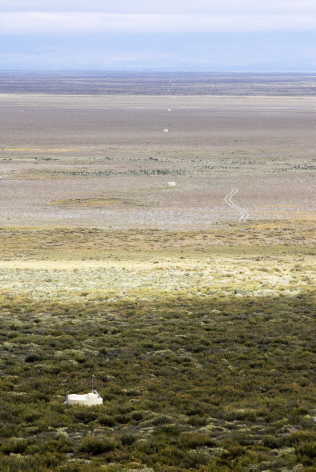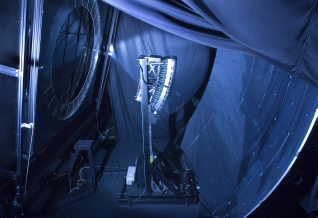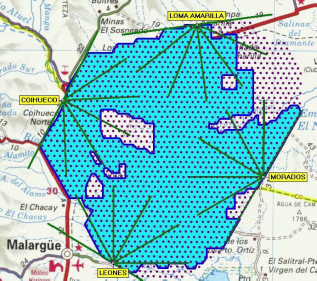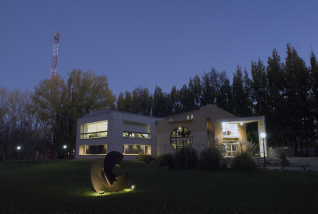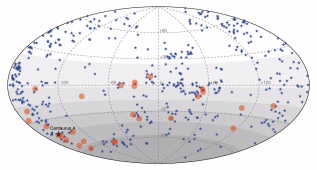|
Dr. Elisabeth Zuber-Knost Kaiserstraße 12 | |
|
A nearly one-hundred-year-old problem is close to its solution: The Pierre Auger Observatory in Argentina has discovered that the distribution of so-called active galaxy nuclei is reproduced by the directions of incidence of highest-energy particles from the Universe. The track of these particles points from our Milky Way to remote galaxies, where active black holes probably are the source of the extreme particle energies, about which physicists and astronomers have been wondering for decades. Each of these black holes consists of a highly compact accumulation of matter amounting to more than a hundred million solar masses. With this discovery, the Auger Observatory has opened a new window to the Universe, namely, that of particle astronomy, through which we will gain entirely novel insights. |
For details, please contact: Forschungszentrum Karlsruhe Postfach 3640 |
|
In the Argentine pampas of Amarilla, 1000 kilometers west of Buenos Aires in the province of Mendoza, the Pierre Auger Observatory is being set up, the largest measurement field in the world to study cosmic radiation. Here, particles of the highest energy, which can be found in the Universe, are investigated. The energies are several hundred of millions times higher than those generated in the largest particle accelerators on earth. However, such particles are extremely rare: Only some dozens of such events have been measured since the first pioneer experiments in the 1960s.
The low intensity of less than one particle per square kilometer and century forced the researchers to cover an enormous area with detectors. The basis of their work is the discovery by Pierre Auger in 1938: At high altitude, cosmic particles collide with the atomic nuclei of the air and generate (according to Einstein’s formula E = mc2) billions of new particles that hit the earth’s surface in the form of a short shower that has the speed of light and may cover an area of several ten square kilometers. The Auger Observatory detects such cosmic particle showers with a network of 1600 particle detectors that are set up in the flat pampas on an area of 3000 square kilometers at a distance of 1.5 kilometers from each other (Figs. 1 and 2). Instruments of highest performance, which were developed and built under the direction of the German Auger groups, are the 24 electronic telescopes. They record an optical reproduction of the weak traces of the particles in the air during clear and dark nights (Fig. 3). From this, the energy and direction of the particles can be determined much more precisely than it has been possible so far. In addition, researchers may derive information about the original particle that has caused the shower.
So far, maps indicating the directions of origin of cosmic particles have been filled with the directions of low-energy particles in a structure-less manner or they have been nearly empty due to lacking data at high particle energies. However, energy plays a key role in the tracking of the particles, since high-energy particles mostly are hardly deflected by the magnetic fields in the Universe. Moreover, it has not yet been settled how these particles may reach the extremely high energies. Their energy corresponds to about that of a hard hit tennis ball and is concentrated in a single elementary particle or atomic nucleus!
The about 300 physicists and engineers working at the Auger Observatory are constantly analyzing the data that have been recorded by the continuously growing detector system since January 2004 (Figs. 4 and 5). Although the first extension in the southern hemisphere in Argentina will be completed in a few months only, the researchers have already been hit by surprise: There is a distinct pattern in the directions of the particles!
The map shows that the Auger particles do not come homogeneously from all directions, but are connected with assumed black holes that are located in the center of so-called active galaxies (Fig. 6). Black holes are presumed in the centers of most galaxies, also in our Milky Way. While most of them behave “calmly”, extreme conditions prevail in about 1% of the galaxy nuclei. Giant masses of matter fall into the central black hole, with part of the energy released being converted into a beam of gas, particles, and radiation that spreads along the rotation axis of the galaxy sometimes over millions of light-years.
“We have made a large step towards solving the miracle of highest-energy cosmic radiation”, says Nobel prize winner James Cronin from Chicago, who conceived the Auger project together with the British Alan Watson in the early 1990s.
“We are beginning to understand which incredible processes take place near black holes and how the particles spread through cosmic magnetic fields”, rejoices Peter Biermann from the Max Planck Institute for Radioastronomy in Bonn, who has been studying this issue theoretically for several years now.
“The German contribution to the Pierre Auger Observatory and to this result is enormous”, states Johannes Blümer from the Forschungszentrum Karlsruhe and the Karlsruhe Institute of Technology (KIT).
“Interaction of the Helmholtz Association and universities is optimal. At Aachen, Karlsruhe, Siegen, and Wuppertal, we very successfully cooperated above all in the development and setup of the telescope systems”, underlines Karl-Heinz Kampert from the University of Wuppertal. Blümer adds: “Building the Observatory at Mendoza is a fantastic international achievement. The results published today mean that we are on the right way and have to see the complete sky in the light of highest-energy particles …”.
Consequently, the scientists involved are already planning an even larger observatory in the northern hemisphere, namely, in Colorado, USA. The Auger result also is of relevance to other large-scale projects in astroparticle physics. Christian Spiering from DESY points out: ”The Auger result also means that active galaxies emit energy-rich neutrinos which will probably be recorded with the IceCube detector in the ice of the Antarctic in a few years from now”. For future experiments and analyses, all interpretations suggest to use an integrated approach that combines all information on light, gamma radiation, particles, and neutrinos.
In Germany, the Forschungszentrum Karlsruhe, member of the Helmholtz Association and partner of the KIT, the universities of Aachen, Karlsruhe, Siegen, and Wuppertal, and the Max Planck Institute of Radioastronomy in Bonn are involved in the Pierre Auger experiment. The project is funded by the Helmholtz Association, the Federal Ministry of Research (funding program: Earth-based astrophysics and astroparticle physics), the Deutsche Forschungsgemeinschaft (German Research Foundation), and the federal states of Baden-Württemberg and Northrhine-Westphalia.
The Karlsruhe Institute of Technology (KIT) represents the merger of the Universität Karlsruhe with the Forschungszentrum Karlsruhe. Altogether, it has 8000 employees and an annual budget of 600 million Euros. In the KIT, both partners are bundling their scientific competences and capacities, establishing optimum research structures, and developing joint strategies and visions.
The KIT will be an institution of internationally excellent research and teaching in natural and engineering sciences. KIT shall attract the best experts from all over the world, set new standards in teaching and promotion of young scientists, and establish the leading European center in the field of energy research. KIT will assume a leading role in nanosciences worldwide. It is the objective of KIT to be one of the most important cooperation partners of industry.
Joachim Hoffmann, November 08, 2007 | |
|
|
Detailed caption of Fig. 1: Particle detector in the pampas: A tank with 12 cubic meters of purest water is equipped with light sensors that detect the weak so-called Cherenkov light that is emitted by energy-rich particles when passing the water. Each tank is operated autonomously with solar electricity (about 10 watts), a GPS receiver for time synchronization, and radio transmission of the data to the central station. In the background, the telescope building “LEONES” is visible, which accommodates six of the telescopes shown in Fig. 3. (Photo by: Pierre Auger Collaboration) |
|
|
Fig. 2: For cost reasons, the mesh of particle detectors is rather coarse. They are located at a distance of 1.5 km from each other. The figure shows some of the water tanks displayed in Fig. 1 (photo by: Forschungszentrum Karlsruhe) |
|
|
Fig. 3: View into a telescope building. At the top left, the inlet window and a ring-shaped correction lens can be seen. The light hits the segmented mirror of eleven square meters in size and is then reflected to the camera with 440 light sensors (center). The camera supplies ten million images per second, from which the traces of the cosmic particle showers are filtered out in real time (photo by: Forschungszentrum Karlsruhe) |
|
|
Fig. 4: Location of the Pierre Auger Observatory in the Argentine province of Mendoza. The central campus is situated in the city of Malargue (Fig. 5). The map shows the positions of the 1600 particle detectors at a distance of 1.5 km from each other (dots) and those of the four telescope stations LEONES, COIHUECO, LOMA AMARILLA, and MORADOS. The blue-shaded area (dark) has already been equipped with detectors. (Photo by: Pierre Auger Collaboration) |
|
|
Fig. 5: Central Auger building on the northern outskirts of the city of Malargue. (Photo by: Forschungszentrum Karlsruhe) |
|
|
Fig. 6: Map indicating the directions of origin of highest-energy cosmic radiation (red disks) that are clearly connected with the positions of active galaxies (blue stars). This finding marks an enormous progress in cosmic radiation research. In addition, the strong radio galaxy Centaurus A that is closest to us is indicated (large black star). Theoreticians predicted it to be a possible source of highest-energy cosmic radiation. The Auger Observatory in Argentina mainly observes the southern sky (dark areas). Observation of the complete sky requires a second facility in the northern hemisphere. For this, a suitable location in south-east Colorado in the USA has been identified. (Drawing by: Pierre Auger Collaboration) |
Press Release 18/2007
Black Holes: Sources of Highest-energy Cosmic Particles?
The International Pierre Auger Observatory for Cosmic Radiation Discovers Relationship between Cosmic Radiation and Active Black Holes
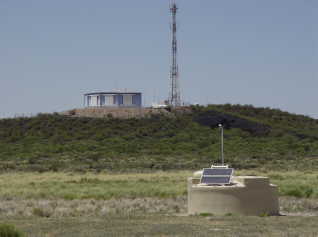
Fig. 1: Particle detector in the pampas
jh, November 08, 2007
Contact:
Monika Landgraf
Chief Communication Officer
Head of Corporate Communications
Chief Press Officer
Phone: +49 721 608-41150
Fax: +49 721 608-43658
presse ∂does-not-exist.kit edu
Contact for this press release:
Inge Arnold
Presse, Kommunikation und Marketing (PKM)
Phone: +49 721 608-22861
Fax: +49 721 608-25080
inge arnold ∂does-not-exist.kit edu
Presse, Kommunikation und Marketing (PKM)
Phone: +49 721 608-22861
Fax: +49 721 608-25080
inge arnold ∂does-not-exist.kit edu
The photo in the best quality available to us may be requested by
presse ∂does-not-exist.kit edu or phone: +49 721 608-41105.
presse ∂does-not-exist.kit edu or phone: +49 721 608-41105.

